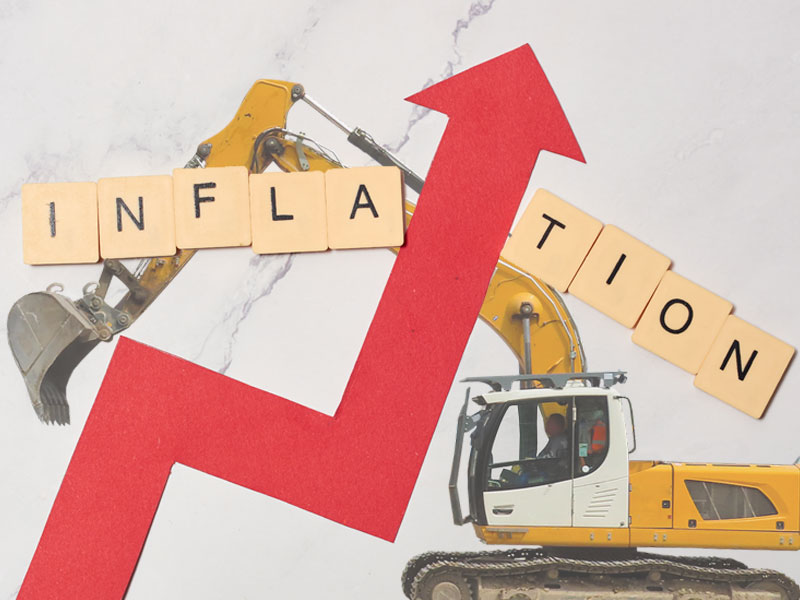
As a general contractor, you’ll be aware that most inflation rates have shown signs of stabilization. However, infrastructure contractors working in the construction sector in Texas continue to face significant inflationary pressures.
In this article, we’ll look at some of the problems we know you face and offer some ways you can overcome the worst of the challenges.
Current Economic Pressures on Infrastructure Contractors
Although national inflation has eased – with the US Consumer Price Index reporting an annual inflation rate of 2.3% as of April 2025 – you’re still likely seeing sharp cost increases on your projects.
There are a few reason for this.
Inflation in the infrastructure construction sector is running well above the national average. Analysts project non-building construction inflation (which includes infrastructure) at 4.3% in 2025.
Because of this, between 2020 and 2023, average project costs in Texas surged more than 30%. This is a combination of material inflation, labor shortages, and financing challenges.
Labor costs are another persistent challenge.
Texas added 28,700 construction jobs from March 2024 to March 2025, one of the highest growth rates in the country. Yet although that signals a healthy pipeline of infrastructure work – including on the I-14 Corridor project – it also puts pressure on wages, especially for experienced tradespeople.
This creates tension for you – between maintaining skilled crews and staying within budget on government-funded projects with tight margins.
Supply chains also continue to pose risk.
Global trade tensions and domestic bottlenecks are contributing to longer lead times for critical components. As of May 2025, signs of accelerating inflation are again emerging in the US economy – due to service-sector growth and potential tariff impacts.
As a result, you might find yourself waiting longer – and paying more – for basic infrastructure materials like concrete piping, traffic signal components, or bridge elements. (And yes, we get how annoying it is!)
You’re also under pressure from higher interest rates, which continue to affect financing. If you’re borrowing either for equipment or for bridging payments on public contracts, the “cost of money” is another challenge to your ability to reinvest or scale.
5 Ways Infrastructure Contractors Can Respond to Inflation
To protect your business from inflation, you obviously need to adapt how you bid, build, and manage risk.
1 Make sure your pricing reflects the real-time cost of materials and labor.
Relying on outdated figures, even by a few months, can lead to underbidding.
Remember that construction inflation is not following general CPI trends. If you’re bidding on a TxDOT project with pricing assumptions from last year, you may already be underbidding.
2 Take a hard look at your contracts.
In public infrastructure work, fixed-price contracts are the norm, but that doesn’t mean you can’t negotiate smarter terms.
Include material price escalation clauses whenever possible – or request cost-adjustable items tied to commodity indices. These types of clauses are now being recommended by multiple industry groups in response to current pricing volatility.
3 You should also diversify your supplier relationships.
Global trade remains unpredictable, and tariffs could raise costs further before the year ends. When you have multiple supply options, you can respond faster to pricing or lead time issues. This is especially useful for long-lead items like precast structures or imported steel.
4 When it comes to labor, investing in your workforce can reduce exposure to the wage inflation you’re already experiencing.
Competition for workers is intense in most US regions, including Texas. Many infrastructure contractors use training and retention strategies – like internal apprenticeship programs, safety-linked bonuses, or the promise of year-round work – to reduce turnover and avoid the hidden costs of constant hiring.
5 Revisit your approach to equipment and overhead.
In some cases, leasing instead of buying equipment can reduce exposure to rate hikes and capital outlays. Other contractors tighten project schedules and crew allocations to minimize downtime and inefficiency – both of which become more costly in an inflationary environment.
Inflation may be slowing for the broader economy, but for infrastructure contractors, it’s still an issue.
Cowboy Trucking is Your Partner of Choice for Quality
With decades of experience in solving challenges, we’ll find the most economical way to help you reduce your expenses with transparent contracts, while maintaining our family’s high standards. Call us for a technical discussion.
